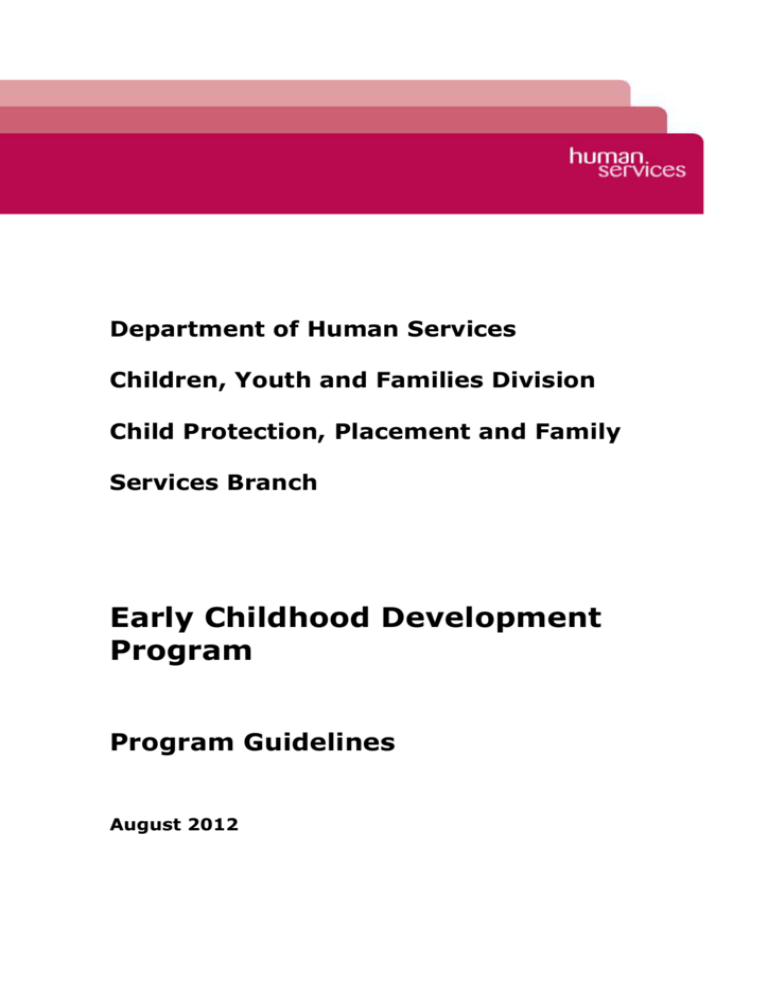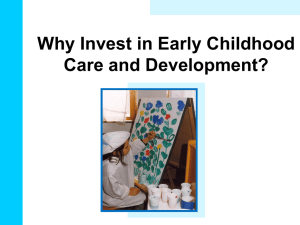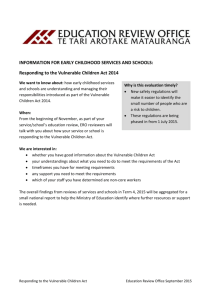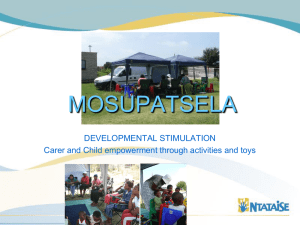Early Childhood Development Program Guidelines
advertisement

Department of Human Services Children, Youth and Families Division Child Protection, Placement and Family Services Branch Early Childhood Development Program Program Guidelines August 2012 Contents CONTENTS ______________________________________________________ 2 PURPOSE PART A: 3 CONTEXT _______________________________________________ 4 1.1 1.2 1.3 1.4 PART B: DEPARTMENT OF HUMAN SERVICES DEPARTMENT OF EDUCATION AND EARLY CHILDHOOD DEVELOPMENT FAMILY SERVICES POLICY CONTEXT 4 4 5 5 ECD PROGRAM GUIDELINES ________________________________ 7 1. ECD PROGRAM OBJECTIVES ________________________________ 7 2. TARGET GROUP ___________________________________________ 7 3. PROGRAM REQUIREMENTS ___________________________________ 7 3.1 3.2 3.3 3.4 3.5 3.6 PROGRAM OVERVIEW PROGRAM MODEL ROLE AND FUNCTION OF THE SECDC ECD PROGRAM PLANS STAFF QUALIFICATIONS AND COMPETENCIES KEY PERFORMANCE OUTCOME MEASURES 7 8 9 10 11 12 4. GENERAL SERVICE REQUIREMENTS ___________________________ 133 4.1 4.2 4.3 4.4 4.5 4.6 4.7 PART C: TERMS AND CONDITIONS SERVICE COLLABORATION AND GOVERNANCE ARRANGEMENTS CULTURALLY COMPETENT SERVICE DELIVERY SUPERVISION AND MANAGEMENT OPERATING ENVIRONMENT PERIODS OF OPERATION PERFORMANCE MONITORING 133 133 133 144 144 144 144 THE SERVICE PROVIDER _________________________________ 155 1. THE SERVICE PROVIDER ________________________________ 155 2 PURPOSE This document has been prepared to provide service providers with program guidelines for the Early Childhood Development Program. Background Early childhood safety, stability and development are the foundations for learning, behaviour and health through school years and into adult life. Children who have negative experiences in their first three years of life can have long-lasting effects on brain development and are more likely to experience behavioural and learning problems, substance abuse, involvement in crime, poor physical health and practise poor parenting. Positive nurturing and experiences, including participation in early years’ services, enhance physical, emotional, social and intellectual wellbeing. Research indicates that active participation in early childhood programs enables vulnerable children to experience positive learning and development opportunities, lessening or eliminating the effects of disadvantage. Research also illustrates that the impact of quality kindergarten is more profound for children experiencing disadvantage, and that vulnerable children benefit from two years of quality kindergarten. The Early Childhood Development Program who will focus on two key objectives: Systemic improvement for vulnerable children (0-5 years) through developing and enhancing partnerships between Child FIRST/Family Services and universal and secondary early years’ services. Service enhancements for vulnerable children (0-5 years) through developing and facilitating targeted capacity building activities to enhance family services and early years’ practitioner skills in assessing, planning and responding to early childhood developmental needs. An evaluation of the ECD pilot project was undertaken by RMIT University during 2011 and this concluded that the ECD projects were meeting the defined objectives. The number of referrals involving children aged 0-5 years from family services to early years services increased markedly and the level of linkages between the two sectors also showed evidence of increase. 3 PART A: 1.1 CONTEXT Department of Human Services Our strategic intent We improve people’s lives and reduce their experience of disadvantage. To achieve this we provide housing and community services to support and protect Victorians most in need. Our mission The Department of Human Services supports Victorians most in need to live safe, happy and fulfilling lives. The Department of Human Services (DHS) is responsible for funding a wide range of services to diverse client groups across Victoria. The department’s principal function is to ensure the delivery of community services and housing. The Children, Youth and Families Division focuses on the health, safety, development, learning and wellbeing of children, young people and families in Victoria. The division plays a key role in the planning and provision of services to Victorian children and their families. 1.2 Department of Education and Early Childhood Development The Department of Education and Early Childhood Development (DEECD) brings together a range of services for young people from before birth to the beginning of adulthood. DEECD has four main responsibilities: provide policy advice to our Ministers about education, early childhood development and children's services in general implement Victorian government policy on early childhood services implement Victorian government policy on school education (including nonschool based education approaches such as home schooling) for all school age students manage and drive continuous improvement in the delivery of primary and secondary education in Victorian government schools. The Department's key responsibilities inform the following outcomes that the Department strives to achieve within its early childhood (children aged 0 – 8 years) learning and development agenda: children have the best start in life to achieve optimal health, development and wellbeing children acquire the basic skills for life and learning all children have access to affordable, high-quality early childhood education in the years before schooling high-quality early childhood education and care supports the workforce participation choices of parents with children in the years before formal schooling. 4 1.3 Family Services Family Services has a critical role in promoting outcomes for vulnerable children and families, and provides a range of service interventions with a whole-of-family focus to: Strengthen parent capability to provide basic care, ensure safety and promote their child's development, and Improve the family's community connections and access to community resources. This requires building and supporting a reliable network of ongoing services, strong linkages and sustained engagement with relevant universal and adult services, and supporting these services to work effectively with vulnerable children and families. 1.4 Policy context The Victoria's Vulnerable Children - Our Shared Responsibility Directions Paper 2012 sets the direction for system wide reform and improvements that aim to improve outcomes for vulnerable children. These directions are in five key action areas: Building effective and connected services Enhancing education and building capacity Making a child-friendly legal system Providing safe, stable and supportive out-of-home care Introducing accountability and transparency The Directions Paper identifies the need for shared responsibility for vulnerable children and families across the community. In line with this shared responsibility, organisations should strive to provide connected services and get those services to those who most need them. Tailored, flexible approaches must be available for groups or communities with specific needs or preferences, including Aboriginal children and their families. Further policy context for the Early Childhood Development Program is provided by: the Children, Youth and Families Act 2005 (the Act) the Strategic Framework for Family Services 2007 the Blueprint for Education and Early Childhood Development, 2008. the Best Interests Case Practice Model and Department of Human Services Standards 2011 Family Services policy framework. Family Services aims to promote the safety, stability and development of vulnerable children, young people and their families, and to build capacity and resilience for children, families and communities. The Strategic Framework for Family Services (2007) supports and enables a primary focus on the best interests of the child or young person in the context of their family and community, taking into account four dimensions of a child’s experience Age, stage, culture and gender 5 Safety Stability Development The framework additionally supports and enables flexible practice that recognises that services need to adjust to the changing needs of vulnerable children, young people and families and promotes purposeful collaboration with other sectors, including universal and secondary early years’ services 6 PART B: 1. ECD PROGRAM GUIDELINES ECD PROGRAM OBJECTIVES The objective of the ECD program is to strengthen the integration, linkages and partnerships between early years’ service providers and Child FIRST/Family Services to maximise vulnerable children and families’ opportunities in accessing and remaining engaged with universal and secondary early years’ services. The ECD program aims to do this through focussing on two key objectives: Systemic improvement for vulnerable children (0-5 years) through developing and enhancing partnerships between Child FIRST/Family Services and universal and secondary early years’ services. Service enhancements for vulnerable children (0-5 years) through developing and facilitating targeted capacity building activities to enhance family services and early years’ practitioner skills in assessing, planning and responding to vulnerable early childhood developmental needs. 2. TARGET GROUP The target group for the ECD program is vulnerable families with children (0-5 years) who are: likely to experience greater challenges as the child’s development has been affected by the experience of risk factors and/or cumulative harm; and/or at risk of concerns escalating and becoming involved with Child Protection if problems are not addressed. likely to be characterised by: o multiple risk factors and long-term chronic needs, meaning that children are at high risk of developmental deficits; o children, young people and families at high risk of long-term involvement in specialist secondary services, such as alcohol and drugs, mental health, family violence and homelessness services; o cycles of disadvantage and poverty resulting in chronic neglect and cumulative harm; o single/definable risk factors that need an individualised, specialised response to ameliorate their circumstances; and o single/definable risk factors that may need specialised one-off, short-term, or episodic assistance to prevent or minimise the escalation of risk. 3. PROGRAM REQUIREMENTS 3.1 Program Overview The role of the Senior Early Childhood Development Coordinator (SEDC) is to strengthen service responses and partnerships between Child FIRST/family services and early years’ service providers to maximise vulnerable children and families’ opportunities in accessing and remaining engaged with early years’ services. 7 3.2 Program Model The intent of the ECD program is to improve systemic and operational responses for vulnerable children and families in recognition of their particular needs and experiences and the subsequent barriers/challenges they may face in accessing and engaging with their local universal and secondary early years’ services. This is to be achieved through focussing on two key objectives: Systemic improvement for vulnerable children (0-5 years) through developing and enhancing partnerships between Child FIRST/Family Services and universal and secondary early years’ services. Service enhancements for vulnerable children (0-5 years) through developing and facilitating targeted capacity building activities to enhance family services and early years’ practitioner skills in assessing, planning and responding to vulnerable early childhood developmental needs. For the ECD program to develop meaningful and sustainable improvement in supporting the objective, the relationship between systemic improvement and service enhancements should be viewed as symbiotic; each informing the development of the other. A planned and balanced approach is required to identify and prioritise the local activities that are required to meet the ECD program objectives. Ongoing analysis of local needs and strengths should determine the emphasis required on those activities that enhance systemic responses and those that will enhance the service delivery practices to maximise vulnerable children and families’ opportunities in accessing and remaining engaged with early years’ services. Models need to be developed and reviewed locally so that the activities of the ECD program align and value add to existing local and regional planning/initiatives/networks, for example; Child and Family Service Alliance catchment plans, Best Start Partnerships, Early Years Municipal Plans, Early Start Kindergarten Partnerships etc. For a model to be appropriate for local requirements, it needs to be developed and reviewed ongoingly with knowledge of the local service system to build upon, not duplicate, existing relationships and partnerships. Further to this, in acknowledgement of the intrinsic role of local government in early years’ service delivery and coordination, the ECD Program model requires development in partnership with local providers and networks. A flowchart identifying possible points of intersection for the SECDC with both Child FIRST/family services and universal and secondary early years’ services has been developed as a reference point (refer attachment A). This should not be viewed as prescriptive of the functions or prioritisation of the SECDC role. The activities undertaken by the SECDC, including the development and review of the ECD program plan, are to be endorsed by the Child and Family Services Alliance and identified key stakeholders. Key stakeholders for the ECD Program are those, as determined and agreed at the local level, which are intrinsic to meeting the objectives of the ECD program. Key stakeholders could include: Child and Family Services Alliance Local early years’ networks and governance mechanisms Pre-school field officers Local Government Maternal and Child Health centres (including enhanced) 8 Best Start partnerships and Aboriginal Best Start Partnerships (where available) Aboriginal Maternal and Child services ( where available) Early Start 3 year old kindergarten initiative partnerships Access to early learning services (where available) Early Parenting Centres Childcare Centres Kindergartens Cradle to Kinder providers 3.3 Role and function of the SECDC It is envisaged that there are a range of activities that can be considered within the role and function of the SECDC, including (but not restricted to): Systemic Improvement: In collaboration, undertaking scoping to identify and prioritise local barriers and challenges for vulnerable families and children in accessing, and engaging with, early years’ services. In collaboration, developing strategic responses to address the identified barriers and challenges for vulnerable children and families in accessing, engaging and remaining engaged with early years’ services. Providing targeted professional education sessions to early years’ services on the specific needs and experiences of vulnerable children and families, and subsequent challenges faced by them in accessing, engaging and remaining involved with early years’ services. (this may be facilitated jointly with early years’ staff) Advocating for, and supporting the development of, strategies between early years’ services and family services in supporting the initial and ongoing engagement and participation in early years services by these families. In collaboration, strengthening referral pathways for early years’ services in accessing Child FIRST/family services and child protection where appropriate. Developing local agreements/protocols between universal and secondary early years’ service providers and Child FIRST / family services. Service Enhancement: Providing targeted professional education sessions to Child FIRST/family services staff on assessing and planning appropriate local service responses to address early childhood developmental needs. (this may be facilitated jointly with early years’ staff) Provision of specific case consultancy on early childhood development for Child FIRST/family services practitioners working with vulnerable children (0-5 years) and families. Provision of consultation to Child FIRST / family services practitioners to enhance and strengthen the development of Child and Family Action Plans to ensure appropriate 9 responses to the developmental needs of vulnerable children are assessed and planned, including appropriate access to universal services is identified and enabled. Supporting Child FIRST/family services case managers to provide individualised, case specific advice to early years’ services in supporting the continued engagement of vulnerable children and families. Providing targeted capacity building activities to child protection practitioners (for example, information sessions on emerging early years initiatives) subject to local agreements and as reflected in the project plan. Other activities as identified through the local ECD program plans. The SECDC is a resource that will be available to both Child FIRST and family services for secondary consultations. Local agreements are to be developed and reviewed to outline how Child FIRST and family services practitioners may access the SECDC for secondary consultations, based on prioritisation of ECD activities and capacity. It is not the intent that the role of the SECDC, in undertaking capacity building activities to enhance service delivery, will have a direct operational role. The activities undertaken by the SECDC should be viewed within a service capacity building and professional development framework to improve Child FIRST/family services practice in responding to the developmental needs of vulnerable children (0-5 years). What the SECDC role is not The functions of the SECDC are not to be confused with that of the community based child protection. This role is therefore not to be used to perform risk assessments for Child FIRST/family services. The SECDC will not be the direct contact for early years’ service providers on specific cases. All case specific consultations between early years’ service providers and Child FIRST/Family Services are to occur with the primary case manager or Child FIRST intake worker. The SECDC may have a role supporting early years’ services as determined through case planning, but is not the primary contact. The SECDC is not to have a direct case work role with families or case management responsibilities. 3.4 ECD program plans Each Alliance is to develop a three year ECD program plan that is reviewed annually. The ECD program plan and annual review is required to be submitted to the region. The development of the three year ECD program plan will be informed by: ongoing review of the identification of the systemic and operational barriers and challenges facing vulnerable children and families in accessing, engaging and remaining connected with early years’ services. ongoing snapshots of local participation rates in early years’ services for vulnerable families and children (0-5 years) currently receiving family services. The ECD program plan is to identify the prioritised local actions that the SECDC, Child and Family Services Alliances and early years’ partners will undertake in response to the 10 identified barriers that limit vulnerable children and families’ opportunities in accessing and remaining engaged with early years’ services. An ECD program plan template has been developed for use by the Child and Family Services Alliances. The program plan should also link to relevant elements of the Alliance catchment plans. The ECD program plan should not only outline the key activities to be undertaken by the SECDC, but also stipulate the target outputs against each activity (for example: the number of professional education sessions that will be provided to universal and secondary early years’ services). These target outputs are to be negotiated with, and endorsed, by the region. An ECD project plan template has been developed for optional use. 3.5 Staff Qualifications and Competencies Senior Early Childhood Development Coordinators are to have high level knowledge of early childhood development and demonstrated knowledge and experience of responding to the needs and challenges faced by vulnerable children and families. SECDC are to be employed to the equivalent of a suitably qualified senior practitioner. Mandatory requirements: A tertiary qualification in Early Childhood Development, Infant Mental Health, Social Work, Psychology or equivalent. Competencies required of the position will include: High level understanding of early childhood development and factors that can impede a child’s development. Demonstrated ability to develop and maintain strong collaborative relationships and partnerships with key stakeholders, including child and family services alliances, Local Government, kindergartens, childcare centres, early parenting centres, Best Start partnerships etc. Ability to undertake program development and implementation; diagnose trends, strengths and obstacles in a complex service environment, understanding the linkages between primary, secondary and tertiary service systems for vulnerable children. Detailed knowledge, or ability to gain knowledge, of local early years’ service responses and interventions that can positively impact on a child’s development, and those that can assist in promoting change in behaviour to increase parenting capacity. Detailed understanding, and ability to communicate, the needs and challenges faced by vulnerable children and families (for example; intergenerational poverty, family violence and conflict, history of abuse and neglect, trauma etc) and the subsequent impact this has on accessing and engaging universal and secondary early years’ services. Ability to provide high level advice on early childhood developmental needs within a family services context. High level communication skills. Ability to provide support to Child FIRST / Family Services case managers to advocate and present cases for access to services on behalf of families. Ability to provide sound advice and recommendations on: 11 Strategies for early years’ services in engaging vulnerable children and families. Interventions required by family services in addressing early childhood developmental needs, and consultation for the purposes of assessment and decision making in the best interests of the child/ren. Ability to understand relevant risk and needs assessment frameworks and appropriate application of these. Knowledge or ability to gain knowledge, of relevant provisions within the Children, Youth and Families Act 2005. Maintain clear and concise records. 3.6 Key performance outcome measures The key performance outcome measures for the ECD Program are: 1. An increase in the number of referrals from Child FIRST/family services to universal and secondary early years’ services. It is the intent of the ECD program to enhance systemic and operational responses to increase the rate of participation for vulnerable children in early years’ services, so that participation rates for vulnerable families and children are comparable to that of the overall population. The ECD project plan will stipulate those activities required to address this key performance outcome measure, and outline the target outputs attributed to these as negotiated with and endorsed by the region. The number of referrals from Child FIRST/family services to universal and secondary early years’ services will be monitored through the ‘referral to’ values recorded under the activities section of the IRIS database, namely: Long Day Care Occasional Care Family Day Care Maternal and Child Health Service Kindergarten Early Parenting Centre DEECD: Early Childhood Intervention Service (ECIS) Cradle to Kinder Program It should be noted that these fields in IRIS are not mandatory, so practitioners may need reminding these fields should be completed where appropriate and will be used for performance monitoring purposes for the ECD programs. 2. Number of professional education sessions provided to Child FIRST/family services 3. Number of professional education sessions provided to universal and secondary early years’ services 4. Number of secondary consultations provided The ECD program plan will stipulate those activities required to address these key performance outcome measures, and outline the target outputs attributed to these as negotiated with and endorsed by the region. The key performance outcome measures will be monitored through the ECD quarterly reports submitted to the region. 12 GENERAL SERVICE REQUIREMENTS 4.1 Terms and Conditions The terms and conditions of the Service Agreement between the facilitating CSO and DHS shall apply to this project. For further information refer to the Funding and Service Agreement Information kit. 4.2 Service Collaboration and governance arrangements The SECDC is accountable to the facilitating CSO. The ECD program plan needs to be endorsed by the Child and family Services Alliance and key stakeholders. The governance arrangements for the service collaboration required to undertake the ECD program is to be determined by each catchment, according to local arrangements/requirements. An ECD program governance structure will provide leadership and an authorising environment for the SECDC to work collaboratively with all stakeholders to enable strategic planning and responses to meet the objectives of the ECD Program The ECD program governance arrangements will be integrated into existing catchment governance arrangements, for example the child and family services alliance, Best Start partnerships etc as deemed appropriate. 4.3 Culturally Competent service delivery The following requirements will also be reflected in the standards for service providers: As an essential precursor to providing culturally competent service responses, service providers will be required to identify the Aboriginal and Torres Strait Islander status of all children; Service providers will be required to actively engage and sustain engagement with Aboriginal Services within its sub-regional catchment area; Engagement with Aboriginal Services is characterised by joint agreements about sustainable strategies to maximise the active participation in critical decisionmaking (both strategic and operational) and should take account of the limited infrastructure of Aboriginal Services; and Consideration needs to be given to: Working within the principles of the Act How to practically include Aboriginal community controlled service providers in the planning, design, operation and strategic management of mainstream services within the sub-regional catchment, especially where there is no Aboriginal placement prevention and/or reunification service established; and Referral pathways between Aboriginal Services and mainstream service providers are established. CSOs should refer to the Aboriginal Cultural Competence Framework, which has been developed to support agencies in delivering cultural competent services. Strategies are to be developed to identify and record cultural identity and establish referral pathways and arrangements with services for families from CALD backgrounds, in particular recent arrivals and refugees. 13 4.4 Supervision and management The facilitating CSO of the ECD Program must be able to provide appropriate professional support and supervision to the SECDC. The SECDC will require high quality supervision, access to quality professional development and service provider support. 4.5 Operating environment Service providers should be equal opportunity employers, offering smoke-free working environment, have appropriate Occupational Health and Safety, including prevention of sexual harassment and violence in the workplace policies and procedures. 4.6 Periods of Operation The majority of the ECD Program is expected to occur between the hours of 9.00am – 5.00pm, but may require operating flexible working hours outside of these times as circumstances require. 4.7 Performance Monitoring Monitoring of service performance will be undertaken through the broader contract management and agency monitoring frameworks of the department. The facilitating agency will be required to submit a quarterly report to the department outlining the activities undertaken as against the program plan. A reporting template is attached. 14 PART C: 1. THE SERVICE PROVIDER THE SERVICE PROVIDER Eligible service providers for the ECD Program must be: a service provider (this can be a partnership with another service providers or a consortia) which is also a legal entity with which DHS has a current service agreement, Registered family service provider under the Children, Youth and Families Act 2005, an active and functional member of the sub-regional Child and Family Services Alliance, a current user or have the capacity to use the Integrated Reports and Information System (IRIS) or other specified data collection, The service provider must also be able to demonstrate an understanding of service requirements and that they have the capacity, including relevant experience and background, staff competencies, service provider structure, technical capacity, infrastructure, and the commitment to deliver the specified project successfully. 15







